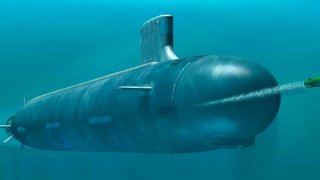China's Submarine Force Is a Clear Threat to the U.S. Navy
China's rapid military development, particularly in its submarine capabilities, has reached a level where it could challenge the U.S. Navy in the undersea domain, especially near Chinese and Taiwanese waters. This development, coupled with China's advanced anti-access/area-denial (A2/AD) systems, threatens to negate the U.S. Navy's traditional advantages.
Summary and Key Points: China's rapid military development, particularly in its submarine capabilities, has reached a level where it could challenge the U.S. Navy in the undersea domain, especially near Chinese and Taiwanese waters. This development, coupled with China's advanced anti-access/area-denial (A2/AD) systems, threatens to negate the U.S. Navy's traditional advantages.
-If the U.S. Navy's submarines are neutralized by China's growing underwater fleet, America's ability to counter a Chinese assault on Taiwan could be severely compromised.
-With the U.S. defense-industrial base struggling to replace lost or damaged submarines, the risk of losing a major conflict with China increases, which could have profound strategic and economic implications globally, particularly concerning the dominance of the U.S. dollar.
China's Submarine Fleet: A Growing Threat to U.S. Naval Dominance
Chinese military capabilities, China’s civilian technological sector, and the country’s overall economy have produced a dynamo. Indeed, from the time China opened itself up to the West in the 1970s, the country has moved from a backward, North Korean-like state run by a vicious cult of personality to being the world’s second-largest economy in GDP terms.
China wasn’t interested in just becoming the sweatshop of the world, making the “developed” world’s goods on the cheap. The Chinese Communist Party always envisioned becoming the seat of the developed world.
Contextualizing the China Dream with China’s Submarine Advances
In order to achieve this “China Dream,” as Chinese President Xi Jinping dubbed it, China cannot just become an economic and technological dynamo. It must become a dominant world military as well, and that is precisely what China has done. In the last decade alone, China’s military has developed at a disturbing clip.
One area the Americans never believed the Chinese military could challenge them was in the maritime domain. Specifically, in the undersea arena. That domain was always dominated by the U.S. Navy – and maybe, the Russian Navy.
Chinese submarines were the butt of jokes throughout the last half of the 20th century. Even at the dawn of this century, when China really started coming into its own as a competitive power, it was still using upgraded Type 091 nuclear-powered submarines, which were in no way competitive with American or Russian equivalents.
The Chinese viewed their awful Type 091 nuclear submarine as a stepping stone.
Benjamin Brimelow of Business Insider assesses that, “China has built upon decades of earlier failures to field a growing submarine force whose boats are more capable against the US’s advanced subs in a sign that China believes its ambitions may come down to an undersea fleet that can sink rivals and deter enemies from nuclear attack.”
China, A2/AD, and an Undersea Great Wall
Indeed, the advent of China’s sophisticated anti-access/area-denial (A2/AD) capabilities mean that the bulk of America’s surface warfare fleet – including its potent aircraft carriers – will be unable to get within range of Chinese targets unless they want to risk being destroyed by China’s anti-ship ballistic missiles and hypersonic kill vehicles.
The Americans will have to rely heavily on their nuclear submarine capabilities to get underneath those A2/AD systems.

That’s where China’s growing submersible threat enters the fray. If those American nuclear submarines meet a wall of steel beneath the sea, then the ability for Washington to prevent, say, a Chinese run on Taiwan will be completely negated by the Chinese.
And that’s the point.
Chinese submarines have reached parity with U.S. submarines at least when it comes to the territories closest to China and Taiwan, where U.S. submarines would be required to operate in any conflict with China. What’s more, America’s broken defense-industrial base – notably its sclerotic shipyards – means that once submarines are lost or damaged in combat, replacing them in a wartime setting will be a bear.
All this combines to mean that the United States will likely lose a major war with China if trends and conditions persist. Once that occurs, in the larger strategic sense, the China- and Russia-led BRICS alliance threat to the US dollar’s dominance will become more real than it presently is, as the world questions the competency and reliability of the United States.
Author Experience and Expertise: Brandon J. Weichert
Brandon J. Weichert, a National Interest national security analyst, is a former Congressional staffer and geopolitical analyst who is a contributor at The Washington Times, the Asia Times, and The-Pipeline. He is the author of Winning Space: How America Remains a Superpower, Biohacked: China’s Race to Control Life, and The Shadow War: Iran’s Quest for Supremacy. His next book, A Disaster of Our Own Making: How the West Lost Ukraine, is due October 22 from Encounter Books. Weichert can be followed via Twitter @WeTheBrandon.
All images on the page come from Shutterstock or Creative Commons.
From the Vault
Russia Freaked Out: Why the U.S. Navy 'Unretired' the Iowa-Class Battleships
Battleship vs. Battlecruiser: Iowa-Class vs. Russia's Kirov-Class (Who Wins?)


